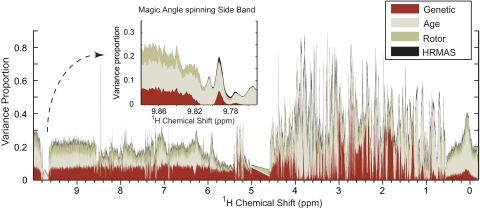Fig. 2.
Characterization of biological and technological factors. The effects of biological factors (i.e., genetics and age) and technological factors (i.e., rotor filling and instrumental reproducibility) were assessed by an O2PLS (29) variance component model by using a 24 full factorial design as Y matrix and NMR as X matrix. For each NMR variable, the model computes the proportion of variance (scaled to 1.0) attributed to each one of the four factors (genetics, age, rotor, and HRMAS) across the entire 1H HRMAS-NMR spectrum; the remaining white area corresponds to the residual of the model with a total of 100%. The maximum of the variance proportion for each factor is 54%, 82%, 21%, and 8% for genetics, age, rotor filling, and instrumental reproducibility, respectively. Biological factors show the strongest variance proportions in the aliphatic part of the spectrum (δ[0;4.6]), whereas technological parameters such as instrumental reproducibility show a stronger variance proportion in the magic angle spinning side bands of the residual water signal (δ 9.79), for instance. Further scores, loadings, and internal validation are presented in SI Fig. 5.

